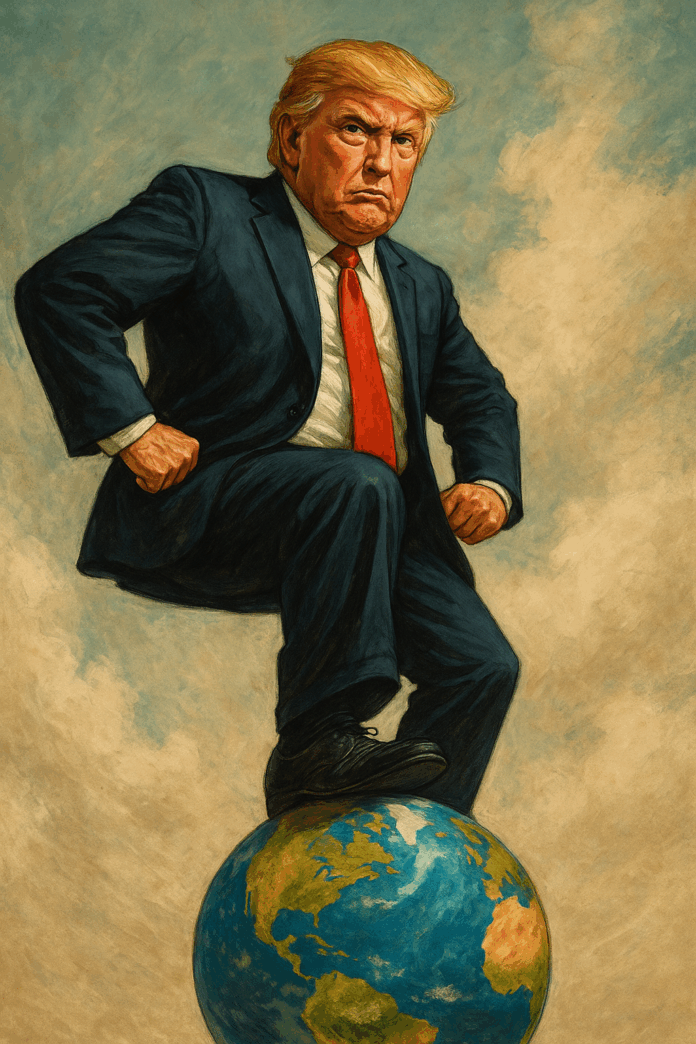A President Wielding Tariffs Like Swords
In an escalating demonstration of raw executive power, President Donald Trump has unveiled a new series of aggressive Trump tariffs, affecting some of the United States’ largest trading partners. From the 50% hammer on Brazil, to a 15% deal with the EU and South Korea, and now a 25% punitive strike on Indian exports, this tariff offensive reveals more than just protectionism, it unveils a strategic, calculated reconfiguration of global power relations. Under the guise of national security and fair trade, Trump is redrawing the map of alliances and submission.
Brazil – Tariffs as Political Ammunition
On July 30, 2025, Trump signed an executive order imposing a 50% tariff on most Brazilian imports, effective August 6. Key exports like aircraft, orange juice, and aluminum were spared, an intentional calibration. More provocatively, the U.S. Treasury slapped personal sanctions on Supreme Court Justice Alexandre de Moraes, who is overseeing the prosecution of Trump ally Jair Bolsonaro for alleged coup plotting.
Invoking the Global Magnitsky Act, the U.S. accused Moraes of “political persecution” and “arbitrary detentions,” including censorship of American platforms like X and Rumble. For Trump, this is a clear message: U.S. allies who prosecute right-wing populists will face the full weight of American economic might. Brazil’s President Lula da Silva decried the move as an “unjustifiable attack on national sovereignty,” while Human Rights Watch warned of dangerous overreach into Brazil’s judicial independence.
European Union – A Bitter Pill with 15% Tariffs
After high-stakes negotiations, the EU narrowly avoided a tariff escalation, settling for a 15% across-the-board tariff instead of the initial 25% Trump threatened. While Brussels spun it as a “predictable framework,” the mood in Paris was one of humiliation.
President Emmanuel Macron, sidelined from the final negotiations, publicly lamented the deal as a “submission,” declaring that Europe had “failed to make itself feared.” In truth, this was less a trade agreement than a face-saving retreat. Despite its economic weight, the EU again fragmented under pressure, allowing Washington to dictate the rules and the tempo.
South Korea – An Energy-for-Tariffs Bargain
Seoul, playing the realpolitik card, secured a deal that capped tariffs at 15%, down from Trump’s original threat of 25%. In exchange, South Korea pledged $350 billion in U.S.-based investments, including $100 billion in LNG and other energy purchases. It was a textbook Trump bargain: energy leverage, defense dependency, and fear of losing U.S. market access, all wrapped in a smiling bilateral handshake.
This isn’t diplomacy, it’s business by blackmail. Yet South Korea, fearing economic instability and regional isolation, chose compliance over confrontation.
India – The Next Battleground
India, once touted as a rising partner, now finds itself in Trump’s crosshairs. Beginning August 1, Indian exports will face 25% tariffs, along with an unspecified penalty for continuing to purchase Russian oil. While bilateral negotiations continue, no breakthrough has emerged. Delhi remains unwilling to fully open its agricultural markets, while Washington pushes hard for reciprocal trade access and a curb on defense deals with Moscow.
India walks a tightrope, balancing its sovereign energy strategy and military procurement policies with the risk of alienating a belligerent White House.
Other Fronts – Mexico, Canada, Japan Under Pressure
Mexico and Canada, long considered NAFTA stalwarts, are now also under discreet pressure. Trump has floated punitive tariffs against Mexican produce and Canadian timber, citing alleged border and trade policy “violations.” Meanwhile, Japan, the Philippines, and Indonesia signed provisional frameworks to avoid the August 1 cutoff, but none of these agreements are formal, binding treaties. The U.S. keeps the language vague on purpose, to declare “victory” while preserving future leverage.
A Submissive Global Order – Where Is the Resistance?
An unsettling question looms: how does Trump continue to strongarm entire sovereign blocs with such ease? The truth is not in America’s economic gravity alone, but in the collective cowardice of the targeted nations. The EU, India, Brazil, Korea, each one faced with unilateral ultimatums, has chosen to negotiate separately, quietly, and ultimately capitulate.
Imagine a world where these economic giants stood together, refusing to submit to Washington’s coercion. The power balance would shift overnight. But instead, they avert confrontation, paralyzed by fear of dollar sanctions, tech restrictions, or retaliatory tariffs. They play by rules the U.S. ignores. And Trump, a master of divide and dominate, takes full advantage.
The result: a return to imperial trade politics, where “free markets” are just rhetorical armor for economic domination.
Legal Challenge – A Blow to Trump’s Expansive Powers?
A faint light emerged from within the U.S. legal system itself. In late July, the Court of International Trade ruled that several Trump-imposed tariffs violated the Emergency Economic Powers Act, calling into question the legal foundation of his trade war expansion. While implementation of this ruling remains uncertain, it marks a rare institutional pushback to Trump’s autocratic use of trade levers. Still, such resistance is limited, and likely too late to stop the August tariffs from reshaping global commerce.
The New Trade Order
With his escalating Trump tariffs, Donald Trump isn’t merely shaping trade policy, he’s engineering a global submission doctrine, leveraging U.S. market power to punish dissent, reward loyalty, and entrench ideological allies. While Korea and the EU bow, Brazil resists under duress, and India negotiates under threat. Trump’s message is clear: comply, or be crushed.
And what of the world? Watching, whining, but not uniting.



